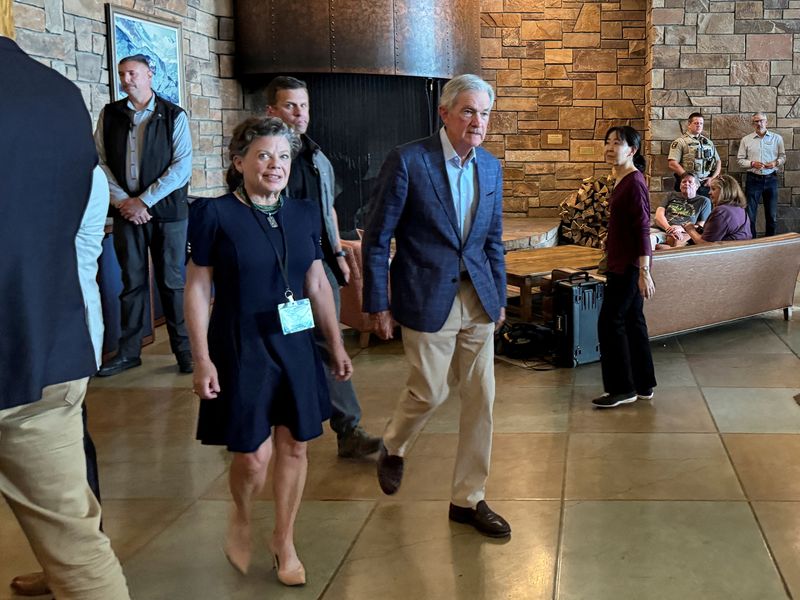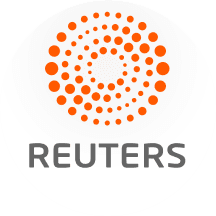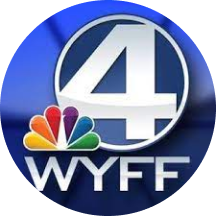
NEW YORK (Reuters) -U.S. Federal Reserve Chair Jerome Powell on Friday pointed to a possible rate cut at the central bank's September meeting but stopped short of committing to it in remarks that walked a narrow line acknowledging growing risks to the job market while also saying risks of higher inflation remain.
"While the labor market appears to be in balance, it is a curious kind of balance that results from a marked slowing in both the supply of and demand for workers," Powell told an audience of international economists and policymakers at the Fed's annual conference in Jackson Hole, Wyoming.
MARKET REACTION:
STOCKS: U.S. stocks extended gains after Fed's Powell's remarks.BONDS: U.S. Treasury yields dropped as Fed's Powell alluded to rate cuts.
FOREX: The dollar fell after Powell's comments.
COMMENTS:
HELEN GIVEN, DIRECTOR OF TRADING, MONEX USA, WASHINGTON:
"The dollar short is back in a big way today after both Powell's speech at Jackson Hole and Trump's threats this morning to fire Fed Governor Lisa Cook. The first material move came, naturally, as Powell noted that downside risks to the labor market are weighing more heavily on the Fed's decision-making process - hardly a surprise following July's dismal labor figures."
"The response we're seeing in FX markets is tied pretty directly to substantially increased odds of a 25 basis-point interest rate cut in September as Powell decisively opened the door to that this morning. Traders see a decent chance of a further 25 basis point cut later this year, too, and overnight swaps are placing big bets on substantial easing for the first half of 2026."
"Trump's words on Cook, too, are once again raising concerns over the Fed's independence as it becomes more clear the Administration may be looking to remake the Fed in its own image, so to speak. Should Trump get the rate cuts he wants from Powell & co through the back half of this year, Powell may last through the remainder of his term as Chair, but as of now markets are still unconvinced that any Fed action through this year may be enough for Trump."
IPEK OZKARDESKAYA, SENIOR ANALYST, SWISSQUOTE BANK, SWITZERLAND:
"It's quite interesting because what we see today is that the Fed, or at least Jerome Powell, is tilting towards a more dovish stance in order to prop up the weakening jobs market. So that's actually a dovish shift that we see in the Fed policy that matches the recent market expectations."
"The fact that the Fed is now preparing to give the market that 25 basis point rate cut, at least that they were expecting, is obviously creating a lot of euphoria."
THOMAS HAYES, CHAIRMAN, GREAT HILL CAPITAL LLC, NEW YORK"
"Chair Powell came in more dovish than expected. He has set the table to move in September. The only thing that could derail that would be an excessively strong jobs report in the first week of September, but based on the trends that we're seeing on a weekly basis and the revisions, that is unlikely."
KARL SCHAMOTTA, CHIEF MARKET STRATEGIST, CORPAY, TORONTO:
"Powell delivered an extraordinarily dovish message here, far more dovish than markets had anticipated. The dollar is plunging, odds on a September rate cut are rising and market participants are clearly bracing for more easing to come."
"What we are seeing here is a clear emphasis on downside risks to labor markets. Powell does give short shrift to inflation risks to some extent. He talks about the possibility for wages and consumer price expectations to become somewhat unanchored. But he's also pointing to the fact that they are at this moment quite well anchored and he talks about the slowdown in consumer demand. I think that's very key because that is typically what central bankers see as an expansion of slack in the economy. In other words, room for inflation to rise or for price increases to avoid triggering big rises in headline inflation."
"The other piece is he says, very importantly, that the labor market appears to be in balance, but it's a curious kind of balance that results from a market slowing in both the supply and demand for workers. And he says we do see downside risks to employment and if those risks materialize, they can do so quickly in the form of sharply higher layoffs and rising unemployment. So, what he's really saying there is that they are bracing for a pivot in labor market conditions and that the second half of the Fed's mandate has suddenly become much, much more important in terms of defining policy settings."
JAY HATFIELD, CHIEF EXECUTIVE OFFICER, INFRASTRUCTURE CAPITAL MANAGEMENT, NEW YORK:
"Obviously, Powell was more dovish than the market expected, but he is responding to the weakening of the labor market, recognizing the risks there. So it sets us up for a September cut. That's a positive."
"We have already expected a cut, so we're neutral on the market now. Normally we would be negative in the fall, but we're just neutral, which is pretty bullish for this time of the year. We're relieved Powell is not completely clueless."
ART HOGAN, CHIEF MARKET STRATEGIST, B RILEY WEALTH, NEW YORK:
"Chair Powell was able to talk about the balance of risk shifting and therefore the potential of shifting of policy would be appropriate. That's a clear hint that Chair Powell is open to supporting rate cuts in the future, likely in September, again in October and then again in December. So, leaning into the fact that the labor market weakness is clearly the driver as opposed to concern over the core goods price increases that we've seen because of tariffs...The clear message to the market is September is now very live."
BRIAN JACOBSEN, CHIEF ECONOMIST, ANNEX WEALTH MANAGEMENT, BROOKFIELD, WISCONSIN: VIA EMAIL
"The Fed isn't going to be the party-pooper. Chair Powell has shown he has an open-mind to reading the data tea leaves. The downside risks to the labor market have risen and while they are still worried about inflation expectations, they aren't going to prioritize the unknowable inflation expectations risk over the known risks to growth."
(Compiled by the Global Finance & Markets Breaking News team)

 Reuters US Economy
Reuters US Economy
 Daily Voice
Daily Voice WYFF News 4
WYFF News 4 New York Post
New York Post CBS News
CBS News Asheville Citizen Times
Asheville Citizen Times Aurora Sentinel
Aurora Sentinel The Argus Leader
The Argus Leader FOX 13 Seattle Politics
FOX 13 Seattle Politics